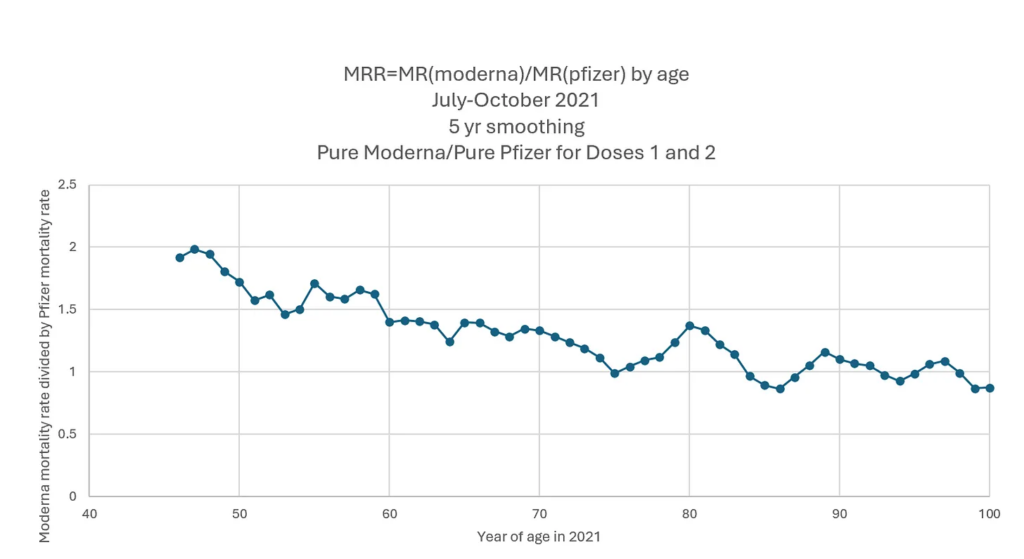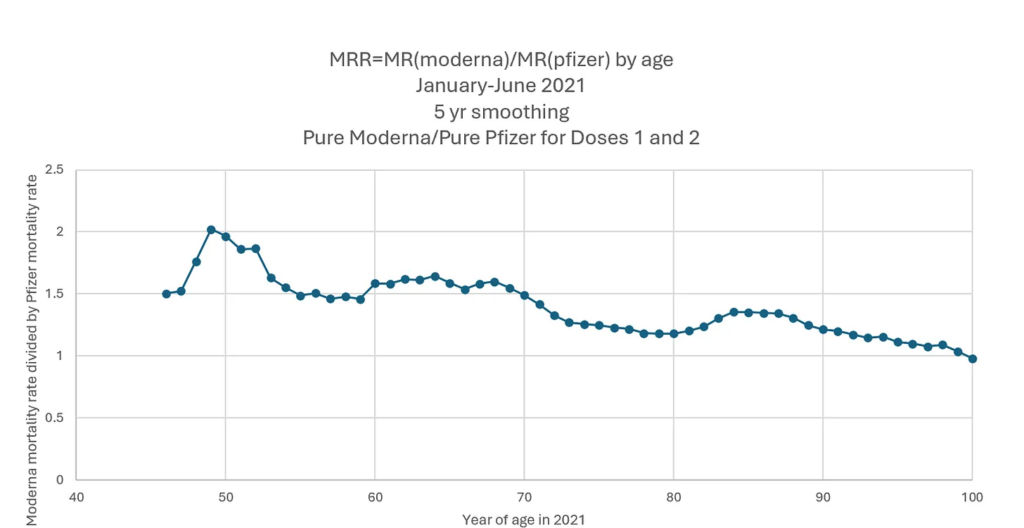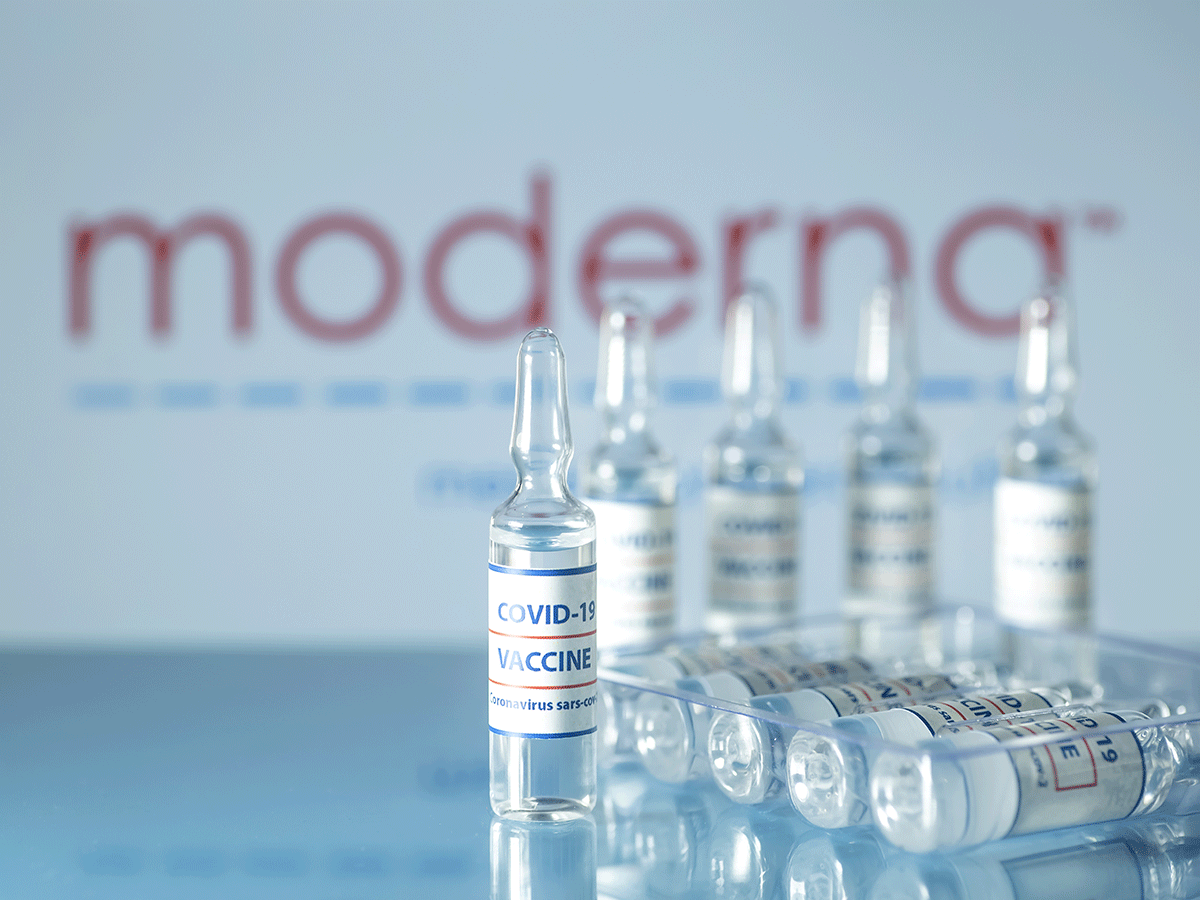Steve Kirsch has made a critical finding in the record-level data from Czechia obtained via Freedom of Information request.
First, let’s just toy with an idea.
If a widely given drug caused death in one in 1,000, what would the impact be?
For young people the impact would be astounding. There would be a huge number of extra deaths and a stunning number of total deaths compared to those who did not take the drug. For 100,000 people there would be only 55 background deaths and 100 extra deaths. Comparing two similar sized populations the overall mortality would be 155 ÷ 55 = 2.82 times more, i.e., 182% higher.
For old people the impact would be much more subtle. For example, around 2% of people aged 80-89 will die in a year. For 100,000 people there would be 2,000 background deaths and only 100 extra deaths. Comparing two similar sized populations the overall mortality would be 2,100 ÷ 2,000 = 1.05 time more, i.e., just 5% higher.
Ultimately any signal would be much clearer in the young.
The Czech Government has released record-level data for 10 million people. The clever analysis Steve has done is based on the assumption that the Pfizer/BioNTech vaccine was harmless. It can then act as a ‘placebo’ group. It is an excellent ‘placebo’ group because confounders around health and socioeconomic variables are accounted for as the brands were distributed randomly. All that is needed is to compare the overall mortality rate in the year following the first dose in the Moderna group with the Pfizer group. Barely any Moderna doses were given in January and the sick were being prioritised still in February so the graph below shows only March onwards. The x-axis is year of age and the y-axis is how much higher (or lower) the Moderna mortality rate is than the Pfizer mortality rate at that year of age, where a value of 1 means the mortality rates are the same. At all ages there were more deaths in the Moderna group – around 50% more in the non-elderly and around 20% more for those in their 70s and 80s. The impact on the young was higher, in line with the dilution effect due to higher background deaths in the old described above.

Unless someone can show that Moderna was given to those more likely to die in every age group and throughout the time period (which is unlikely) then this is compelling evidence that Moderna really was more deadly.
It’s not just a difference in efficacy, i.e., Pfizer preventing more Covid deaths. If it had been there would have been periods when the difference should have disappeared entirely, such as June-October 2021 when Covid deaths were at a low, but the chart below shows that isn’t the case.

For completeness, here is the same graph for January-June when Covid rates were high – the pattern is similar.

A significant number of Czech citizens also had AstraZeneca and their mortality was similar to Moderna’s. The use of Pfizer as a ‘placebo’ group in the above analysis doesn’t mean the Pfizer vaccine was safe. It just shows the Moderna vaccine was less safe.
There is more that can be learnt from these data but this is the first big finding that needs addressing.
Dr. Clare Craig is a diagnostic pathologist and Co-Chair of the HART group. This article first appeared on her Substack. She is the author of Expired – Covid the untold story.












To join in with the discussion please make a donation to The Daily Sceptic.
Profanity and abuse will be removed and may lead to a permanent ban.
Thank you for that analysis.
Unsafe and effective at killing healthy ppl.
The Sheeple will still line up, fully diapered, for the next go around scamdemic. I know people who now have cancer post stabs – they still don’t get it.
The Pfizer vaccine is deadly re Polymyalgia/Giant Cell Arteritis in the elderly so, used as a placebo, it sets an already lethal threshold.
These findings are a ticking time bomb in so many different ways.
https://www.ncbi.nlm.nih.gov/pmc/articles/PMC8810207/
Interesting but predictable data from a Freedom of Information request in Scotland. Good to see the uptake in jabs has tanked and can only reflect the fact many NHS staff have come to terms with the fact they were conned and the only thing to fear is government, especially when they decided to stick their oar in with the restrictions and start killing people/ruining their health, pre and post death jab roll-out;
”The data clearly shows that the vast majority of staff employed by the National Health Service in Scotland were never at serious risk from the virus, and that deaths and disabilities in most front-line occupations actually increased after the Covid–19 vaccinations. A September 2023 study showed that 35% of 1,704 enrolled healthcare workers had to call in sick after Covid ‘vaccination’ and sick leave significantly increased with each subsequent booster.
As of 31 August 2023, a new survey showed that 20% of British doctors are now unable to work due to ‘long Covid’—and yet we see in Scotland, no doctor actually died involving the virus in 2020 and more deaths ensued after the vaccine rollout.
Interestingly, around 50% of NHS staff are declining both COVID and flu vaccinations.”
https://biologyphenom.substack.com/p/foi-covid-19-nhs-occupations-on-the
As of 31 August 2023, a new survey showed that 20% of British doctors are now unable to work due to ‘long Covid’
Quite something. 20% have long poisoning due to their unprofessional stupidity at chasing the £20 per stab fee. Not more than a few will admit that it was the clot shot which is responsible.
20% of doctors *with* long covid are unable to work, not 20% of drs.
Yes, correct. 20% of doctors would be an insanely high number.
It isn’t even an actual business. It was created as a speculative enterprise once the release was planned. They idea was to force through the mRNA revolution. I think we can safely say despite the building of production facilities all over the world, that mRNA may turn out to be known as the most noxous abbreviaton in history. It is up there with the best of them when you look at the death toll Humanity needs a kick up the arse sometimes. You don’t go tampering with the code when you know nothing about it. And if you did know something about it then you wouldn’t tamper with it.
May I just add some new information about the dangers of childhood vaccines?
After decades of gaslighting the public, a new study admits that vaccine safety studies are not conducted before or after use on the public – The Expose (expose-news.com)
The author states that chronic childhood diseases have increased from…
12% of children in the early 1980s,
when CDC recommended 7 routine childhood injections…
to OVER 50% OF CHILDREN NOW,
when CDC recommends OVER 90 routine childhood injections !!!
They stick 90 needles into your child, if you let them…90 needles!
This is Medical Genocide, and Torture.
“As is transparent from their article, the only reason they even pretend to care about vaccine safety is that they want to avoid a reduction in vaccine uptake – not actually assure safety.”
They combine the shots now. Kids receive multiple vaccines in one shot. There has been no safety testing on this
To be fair they did warn in the early 1980s that a pandemic vaccine would function as an aptitude test whereby you kill off the ignorant masses and onl the best remain. Some of them actually believe in that. Maybe one day we will acknowledge the human condition. Human beings function best in groups of between 50 and 300 people. Anything beyond that leads to diminution in qualty of life and inevitable corruption where the strong exploit the weak save a strong abiding faith. These societies with these numbers can’t endure. If you look at it from the point of view of systems analysis you will see that introducing new nodes into a system leads to an exponeniail growth in connections and complexity. Eventually it crashes and the crash is quite sudden. There is nothing you can do to prevent this from happening. You can work on your own survival skills and try to establish reliable networks in your local area. Beyond that it is just a case of trusting in God and tethering your camel.
Neither safe nor effective. And on the other side of the pond, one of the political promoters of them, Joe Biden, has been reported as having an attack of Covid-19 at present. Assuming that’s true, it didn’t do what he said a few years ago – although they might argue that it reduced the severity of the infection.
What an excellent move to compare Moderna’s against Biontech/Pfizer’s jollop. Having now shown that it is more dangerous than the competition and that the deadliness is not due to a difference in effectiveness this opens the door to examining what it does do that causes so much more mortality. If we can start down the track of examining the harms the Moderna jollop actually does we stand a chance of noticing similarities, rather than differences between it and Biontech/Pfizer’s stuff.
I’ve no doubt Pfizer will spin the result to try to do Moderna down – hang onto the thought that the less people trust the vaccine makers, the better in the long term.